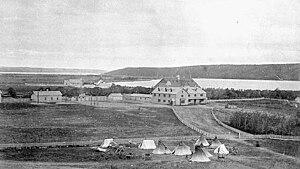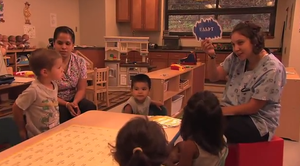Orality and Indigenous Education: The importance of language learning and its effect on health.
Abstract
Language is an integral part of any culture, which is why colonial practices of assimilation created systems that work towards to erasure of Indigenous languages. Systems such as residential schools forced First Nations children in Canada to live and learn at these school, while also punishing and forbidding the use of any cultural practices such as language, spiritual practices, and family relations. Because of these colonial effects, many children who attended residential schools lost their ability to speak their traditional language, which has lead to a dramatic decline in language speakers within many First Nations communities throughout Canada. Nowadays many nations are working towards teaching younger generations their traditional languages so that languages do not go to sleep. Over the past couple of years, there has been more research into the impacts of Indigenous language, one of which has to do with health including both mental and physical. Having the ability to communicate in a traditional language has been shown to decrease the high rates of suicide that are so rampant among the Aboriginal population. There are so many benefits when it comes to Aboriginal youth learning a traditional language, both mentally and physically. This paper will cover the many benefits that come with learning a language and why learning it in an education setting can be so important for those within the community.
Introduction: Background of Indigenous languages in Canada
Erasure of identity and language
Colonization is the practice in which another nation seeks to take over and control all aspects of another country. Within Canada all Indigenous peoples have and are still being subjected to colonial rule. As European colonizers continued to take over what is now Canada, they created the Indian act, a form of legislation that sought to assimilate and disenfranchise the Indigenous peoples of Turtle Island[1][2]. One of the main ways in which assimilation occurred was through the use of residential schools, their main goal to destroy and eradicate any cultural connection that children had to their peoples. Through this many Indigenous peoples lost their languages as they were not permitted to speak their language at school.Now many Indigenous nations are scrambling to increase the amount of language speakers before the last fluent speakers pass on[3].
Assimilation in colonial culture
Because of assimilation, languages have seriously been affected. Parents of Indigenous children are worried that their children will have problems growing up if they do not subscribe to learning the dominant language[3]. Without research that is accessible to the general population, Indigenous parents may choose to have their children grow up with the absence of a traditional language. Through research there have been findings about the positive outcomes of learning a traditional language. Children who grow up learning their native tongue in school tend to have academic scores that are better or on par with those who only learn English, these findings are not replicated for those who are educated in English, with regards to their native tongue[4].
New ways of revitalizing endangered sleeping languages
There are many ways in which languages can be revitalized; however, this requires a lot of hard work. Many nations are turning towards language nests, language classes, and traditional forms of knowledge transfer, such as in house communication. The more effort that is put into learning a language the better it is received by those within the community. Cultural activities and practices which include language learning have been seen to increase well-being and self-esteem within the community[2][4]. Not only are people learning their traditional languages they are also improving their overall well-being. As well being increases this could lead to more vibrant communities that are not afflicted by poverty and suicide.
Health problems with Aboriginal youth
Epidemics within Aboriginal communities
When it comes to health there are differences between Aboriginal populations and the rest of what is now called Canada. Suicide and diabetes are two epidemics that will be talked about throughout this assignment, both of which are astronomically high within Aboriginal communities[5][6]. These higher than normal percentages of morbidity and mortality are cause for concern, so many nations are working towards stopping this cycle. Suicide does not just effect one family it effects communities; reservations are tight knit communities so one suicide can easily effect everyone within the community. Because of the high percentage of suicides within Aboriginal communities, research has focused on how to decrease these rates. Language learning and cultural practices have all been shown to decrease rates of suicides in Aboriginal communities. the more cultural practices that a community is involved in, the lower the levels of suicide are[5]. Within Aboriginal communities language is said to be the crux of all cultural practices, and without language there is no culture, which is why it is so important that language be taught in educational settings[6].
Diabetes
Diabetes is another illness that is ravaging Aboriginal communities in Canada, with the highest percentages in First Nations populations[6]. over the years type two diabetes has steadily increased as colonization strengthened its grip on Indigenous communities of Turtle Island. Culture and language have also been shown to help decrease type 2 diabetes within Aboriginal communities, due to increases in physical activity and an increase in uptake of cultural practices, including interaction with the land[6]. Language intersects with all day to day activities, speakers are better able to communicate with elders to learn ways in which to live with the land, thereby influencing their connection and understanding of how to properly feed and take care of their body. If children are able to learn their traditional language inside schools, they will further their understanding of traditional ways of living, thus improving mental and physical health.
Initiatives to help Aboriginal youth
Real life examples
As seen within research, children are better able to learn their traditional languages within school. Children brains are more malleable giving them an upper hand when learning a language . organizations have formed in order to give funding towards nations who wish to form programs that work to teach people their traditional language. These programs can be expensive, small or impoverished communities may not be able to fund language learning programs.
Language nests, language programs
Language nests have become very popular within Indigenous communities all over the world. within Canada the First Peoples cultural council aims to provide funding for communities who are looking to create language nests or other language programs[7]. Language nests constructive because they amerce children by teaching them state curriculum in their traditional language. As stated before there are no ill effects from a child learning a traditional language[3]. Continued use language nests ensures that younger ages will be able to learn and carry on their language and pass it down to their children. With the proper information and knowledge parents can feel safe and comfortable teaching their children their traditional languages, thereby stopping the dwindling percentages of language speakers. Another great program that exists is the mentor program, where individuals and elders can get paid to interact with one another to learn their language[7]. Mentor programs are great because they provide people of all ages with the ability to interact with an elder, while accompanying them on day to day activities like going to the grocery store. these real life learning opportunities provide a way of learning that is outside of an academic setting, and more in turn which how one would learn a language naturally.
Research finding
Incorporating and implications of research
It is important to recognize that when it comes to language learning there are many different ways that this can be achieved. Colonization has created educational settings where children must go to keep up with what the colonial nation deems is appropriate; however, they fail to acknowledge the importance of traditional languages . As more people begin to understand the benefits of learning a traditional language, the need for language programs will increase, thereby combating the notion that non-dominant languages are unnecessary.
Language is not only important on a cultural scale it is necessary for Indigenous nations, there are so many benefits to learning ones language, not just revolving around health. Indigenous communities fought tooth and nail to ensure that their presence on Turtle Island was not erased and because of it nations are working towards revitalizing and strengthening their cultural ties. It is important that the fight that was in our ancestors continues so that we as Indigenous peoples can continue to teach our youth the importance of culture, and how it defines our relationship with land and our community.
References
- ↑ Government of Canada (2019). "Indian Act". Justice Laws Website.
- ↑ 2.0 2.1 Kant, S., Vertinsky, I., Zheng, B., & Smith, P. M. (2014). "Multi-Domain Subjective Wellbeing of Two Canadian First Nations Communities". World Development. 64: 140–157 – via https://doi.org/10.1016/j.worlddev.2014.05.023.CS1 maint: multiple names: authors list (link)
- ↑ 3.0 3.1 Usborne, E., Peck, J., Smith, D.-L., & Taylor, D. M. (2011). "Learning through an Aboriginal Language: The Impact on Students' English and Aboriginal Language Skills". Canadian Journal of Education / Revue Canadienne de l’éducation. 34(4): 200–215.CS1 maint: multiple names: authors list (link)
- ↑ Guèvremont, A., & Kohen, D. (2017). "Speaking an Aboriginal language and school outcomes for Canadian First Nations children living off reserve". International Journal of Bilingual Education and Bilingualism: 1–12.CS1 maint: multiple names: authors list (link)
- ↑ 5.0 5.1 Hallett, D., Chandler, M. J., & Lalonde, C. E. (2007). "Aboriginal language knowledge and youth suicide". Cognitive Development. 22(3): 392–399 – via https://doi.org/10.1016/j.cogdev.2007.02.001.CS1 maint: multiple names: authors list (link)
- ↑ 6.0 6.1 6.2 6.3 Oster, R. T., Grier, A., Lightning, R., Mayan, M. J., & Toth, E. L. (2014). "Cultural continuity, traditional Indigenous language, and diabetes in Alberta First Nations: a mixed methods study". International Journal for Equity in Health. 13(1): 1–11 – via https://doi.org/10.1186/s12939-014-0092-4.CS1 maint: multiple names: authors list (link)
- ↑ 7.0 7.1 "Language". First Peoples' Cultural Council.

